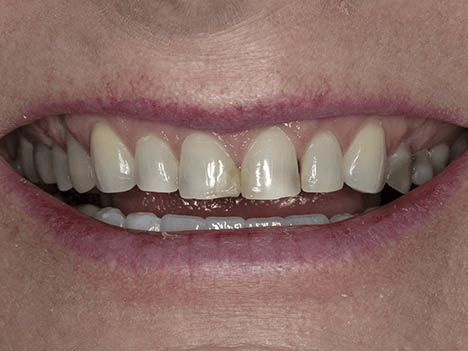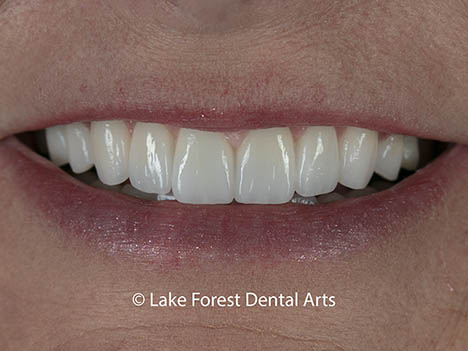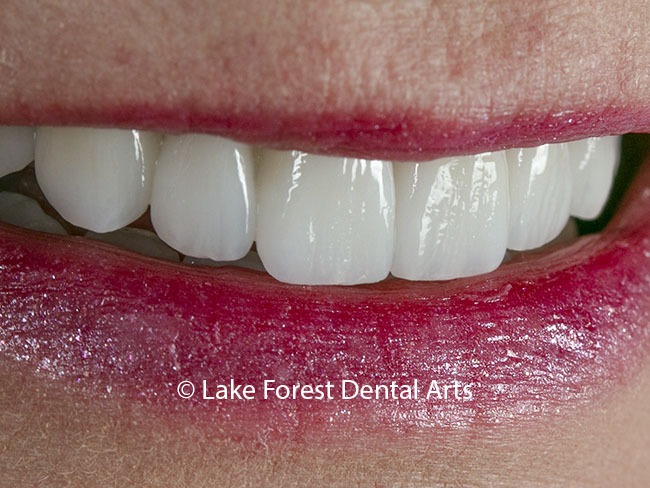 Before
BeforeThe patient’s goals were to straighten her smile, brighten her teeth, repair the decay and chips. Thin veneers will not brighten the teeth much so extensive bleaching was done prior to treatment. The decay was removed first and white fillings were placed. Too much gum showed in her smile initially so she had a minor gum surgery to create better symmetry and to raise the scallops of her gumline.
 After
AfterTen prep-less veneers were done to improve her smile. No temporaries were needed because there was almost no drilling. The only drilling done was to create a very slight margin line hidden under the gum. Creating a margin line improves the long term gum health and reduces the possibility of staining at the edges years after delivery. In the hands of a specially trained ceramist, these E Max monolithic porcelain veneers can be thinned to 0.2mm in thickness.
Which is better veneers or crowns?
Crowns and veneers are the two main cosmetic dental options for transforming your smile. They work mainly by covering over stains and broken teeth with tooth colored porcelain. They also allow improvements in shape and alignment. Both options are popular and they both offer wonderful results. So which is better for the patient, veneers or full crowns? What do cosmetic dentists answer when asked which is better veneers or crowns? It depends on how much of the tooth is missing and the patient’s goals.
The best type of restoration depends on the goal. If the existing tooth has lots of old fillings or is badly broken down from tooth decay, a dental crown is required. Crowns will encase the entire tooth. A veneer only covers the front surface of the tooth and is mainly used for appearance.
Looking closely, it is impossible to tell the difference between a veneer and a crown. In the new world of cosmetic dentistry, both restorations are made of the same porcelain. They are made in the same way in the lab by a ceramist. The only real difference between the two is the amount of the tooth the restoration covers.

Porcelain crowns and veneers are made of the same material and in the same way. There is no difference in appearance. Can you tell which front teeth are crowns and which are covered with veneers?
The thickness of the dental restoration is the main difference
Porcelain veneers are typically a very thin layer of ceramic placed on the front surfaces of teeth. They range in thickness from 1 millimeter down to 0.2mm. Only small amounts of preparation of the tooth to provide room for them. A veneer preparation doesn’t extend to cover the back side of the tooth.
The standard reduction for dental crowns is 2mm or more. Crowns cover the entire tooth and basically remove all of the enamel from the tooth.
The thickness depends on how aggressive your dentist is. Frankly, it is easier for the dentist to drill down your teeth. The temporaries are easier to make. The process to create a crown is easier than for veneers. Heavy prep veneers are easier than light drilling veneers. Light drilling conservative veneers are easier than no drilling veneers.
If the dentist is acting in your best interest, they will drill the absolutely least amount to fulfill the dental need. More skilled cosmetic dentists tend to be more conservative and often are able to maintain more enamel.
Limited Use of the Drill | Conservative Dental Care
An artful aspect of better quality dentistry is achieving an aesthetic goal with the least amount of drilling. Many doctors with less training or experience will use a heavy hand when doing cosmetic procedures such as veneers. They drill away far more valuable tooth structure than necessary.
We strive to limit our dental footprint using the very conservative techniques of “Less Invasive Dentistry“. For example, the tooth must be badly damaged to do a full crown. With few exceptions such a root canal or extreme darkness, more than half of the tooth structure must be missing.
If you have a chipped teeth or smaller portions of the teeth are missing, then a veneer will suffice. If there is significant crowding, misalignment or staining, then a traditional veneer is done. It will have enough thickness of porcelain to brighten the teeth or to mask deeper stains. Lastly, if you have minor spaces, misalignment, or surface blemishes, then veneers without drilling are used.
Why less drilling is better and veneers will always be better than crowns if possible
Traditionally, veneers required substantial drilling of the natural teeth. Now, there are no-prep or conservative alternative types of veneers. When placing custom restorations, there are several reasons why Dr. James Fondriest limits tooth reduction. For example, with less drilling:
- Appointments can be shorter
- Novocaine is often not required
- Temporary veneers, which are incredibly time consuming, may not be necessary
- The impressions are less invasive
- More tooth enamel can be preserved
- The bond between the natural tooth and the veneer is stronger
Are you planning crowns or veneers and need to know which dental procedure is better
Veneers cost the same of slightly more than crowns. They are technically more difficult to do than a full crown even if no temporaries are made. Dental insurance is unlikely to pay for elective dentistry. If the veneers were done purely for cosmetic reasons, there will be no insurance contribution.
If you would like to learn more about both dental veneers and crowns at our Chicago, IL practice, schedule a consultation with Dr. Fondriest by calling 847-234-0517. Taking your unique, personal goals into account, we can help you achieve the bright, dazzling smile you’ve always wanted. We pledge to perform our services in the most conservative way.
Dr Fondriest is a Nationally recognized and highly sought after cosmetic dentist. He serves clients from throughout the United States
